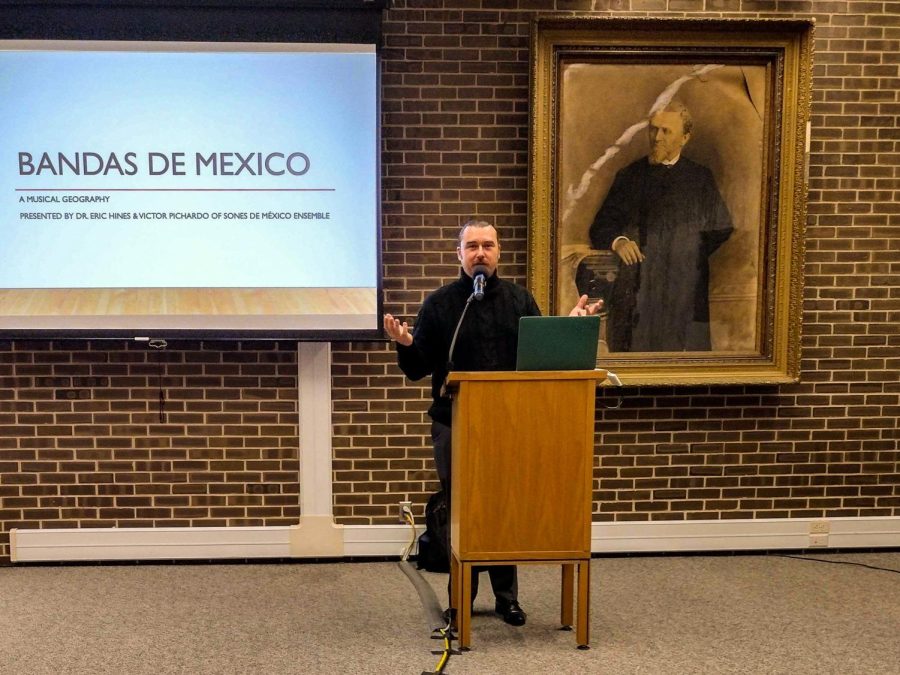Chicago-based percussionist talks geography and musical history of Banda
Eric Hines gave a presentation about the musical history and geography of banda on Nov. 17 in the Founder’s Memorial Library. (Caleb Johnson | Northern Star)
November 21, 2022
Music is at the heart of the human experience. On Nov. 17, people were treated to the musical history of banda in different regions of Mexico. Guest lecturer Eric Hines, an ethnomusicologist and Sones de México Ensemble percussionist, gave an informative presentation in the Founders Memorial Library.
The event featured five different regional styles of traditional Mexican banda, a group of musicians that use woodwind, brass and percussion instruments, from Sinaloa, Zacatecas, Morelos, Oaxaca and Yucatán.
BANDA, MUSICAL GEOGRAPHY
“I’m going to take you on a musical geography throughout Mexico so that you can understand a little more about the origin and roots of banda and the different styles of banda that were developed in different parts of Mexico and still exist today,” Hines said.
According to Hines, the most popular form of banda comes from the Mexican state of Sinaloa. While this contemporary banda is the one most often listened to by people outside of Mexico, it is actually the newest form to take shape.
The origin of banda stretches back to the 1800s and was heavily influenced by external factors. The music was particularly inspired by military marching bands in the United States.
In 1893, the heart of banda was born when John Philip Sousa, a U.S. military band leader, created the sousaphone – a specialized form of a tuba created so it could more easily be used in a marching band.
“The sousaphone is kind of like the king of the banda ensemble. They have tremendous sousaphone players in this genre of music that played virtuosic baselines,” Hines said.
Hines said that Mexican banda came together with a combination of different influences, especially European dance music such as polka, mazurka and waltzes; these dances were very important in developing modern banda.
When discussing Mexican banda becoming more popular outside of Mexico, Hines said a banda group created by Mexican President Porfirio Díaz had a 76-member band play for six months at a culture expo in New Orleans. After a composer wrote down their music, it became very popular. “Over the Waves” was one of their most successful pieces and is still being performed today.
Hines said that throughout the Yucatán region, there is Cuban influence in the instruments as well; banda players adapted them for playing in Mexican banda music. These influences can still be seen today.
IMPORTANT TRADITIONS
Another important banda tradition comes from the state of Oaxaca. According to Hines, this state has beautiful indigenous cultures. From this region also comes a historic group, “Mujeres del Viento Florido.” This group is composed of only women, mostly indigenous, and is the first banda of its kind, as traditionally the field is dominated by men. The group sings in both Spanish and their indigenous languages.
Hines said how important spreading the knowledge of history and how playing in his banda group based out of Chicago helps him make a difference in the lower-income neighborhoods.
According to co-founder Victor Pichardo, Sones de México was started in 1994 in part by himself and Juan Díes in Chicago’s Pilsen neighborhood.
“We decided to start a band which would represent all the styles of music that we have in Mexico and the style which is most important and has all the culture and musical spirit is ‘Son,'” Pichardo said.
Son is the encompassing name for the style of music that the Sones de México plays, and Pichardo said this style is the heart of music and is connected to the musical tradition of Mexico.
Overall, the event was very informative and helped me feel deeply connected to my cultural heritage. The idea of using music to preserve and study history is fascinating. Hines and Sones de México are doing great work to help build community and keep Mexican culture alive in the U.S.
FUTURE PLANS
Hines said he wishes to expand his work and do more workshops and lectures in the future. Hines said he started his research in Cuban music and then switched to Mexican music when he moved to Chicago and became involved with Sones.
Hines and Sones de México are using music to help keep kids off the street and to help embrace their cultural traditions by offering a number of music education courses and instrument tutorials online and in their Chicago office. These courses are a great way to become involved in cultural experiences and expand one’s knowledge and understanding of music.
To connect with Sones de México and to find out about upcoming shows, albums, outreach work and more, visit their website.
This presentation was organized by Gwen Gregory, associate dean for collections management in the NIU University Libraries.
Gregory said she wants to have more cultural events like this one and that she was very pleased with how everything turned out.







